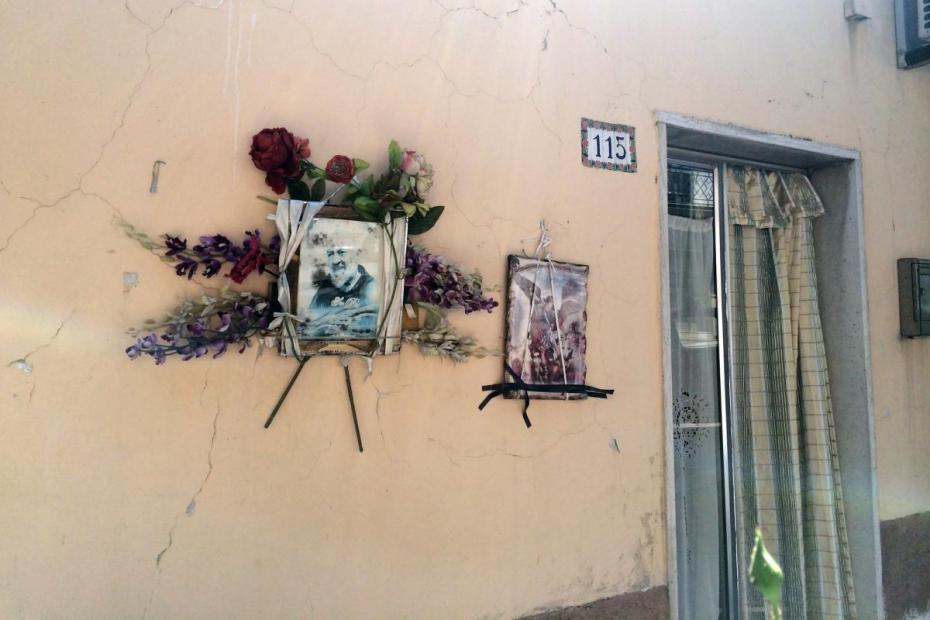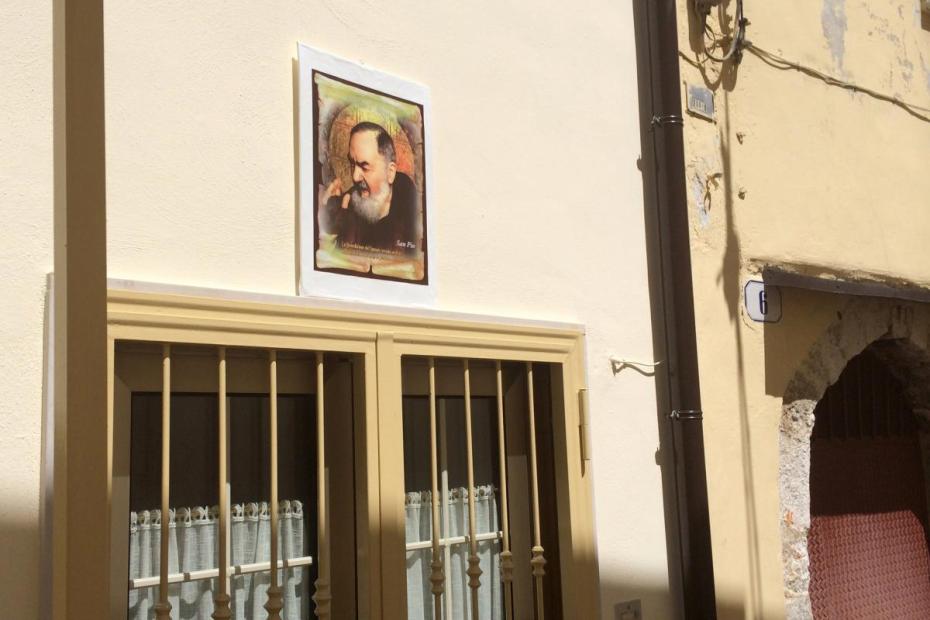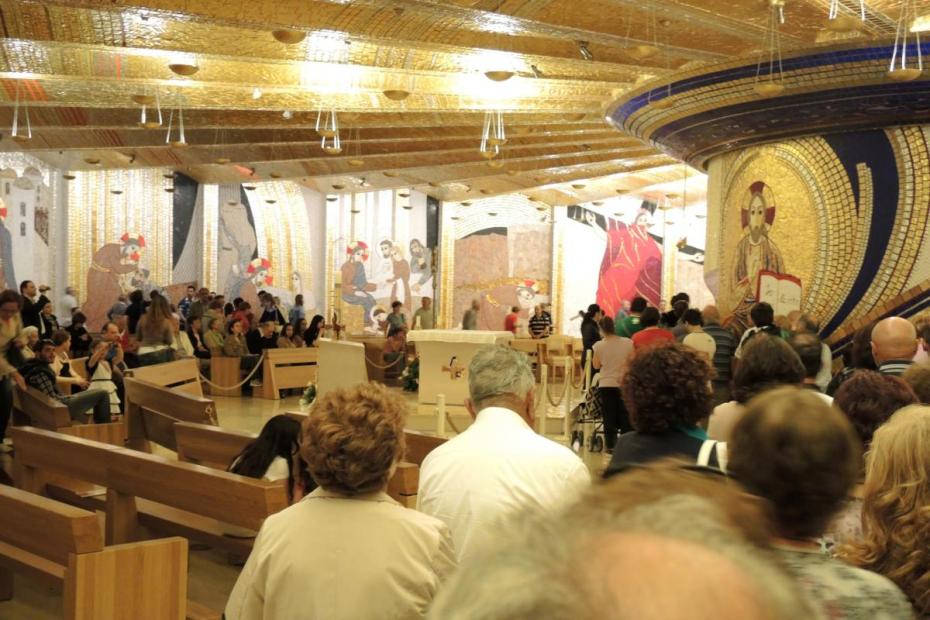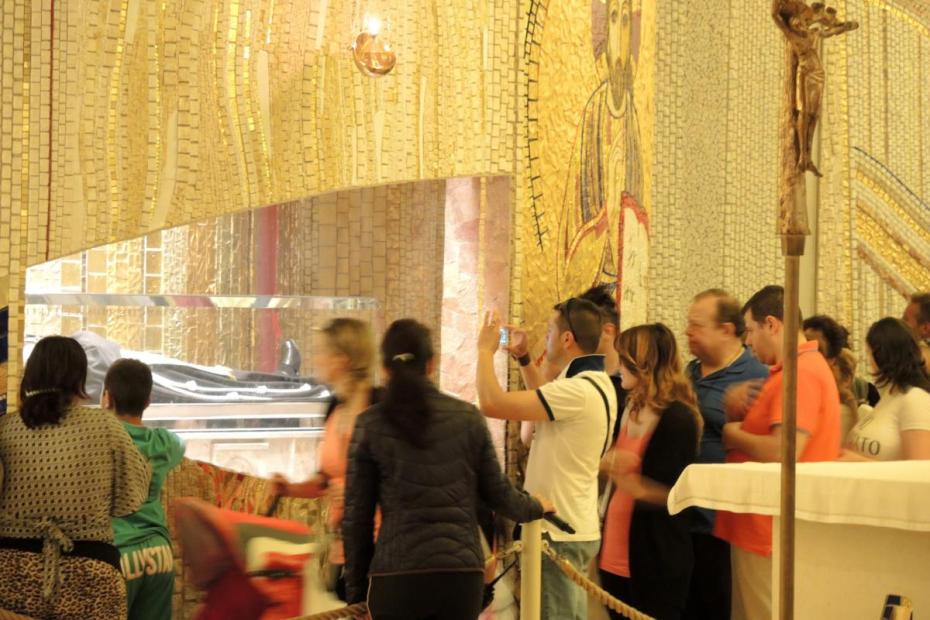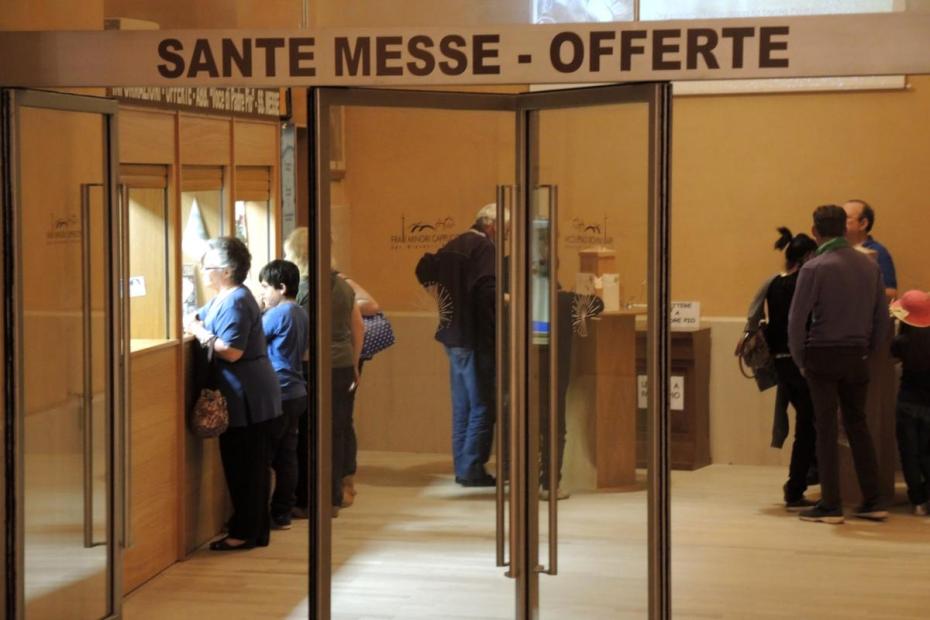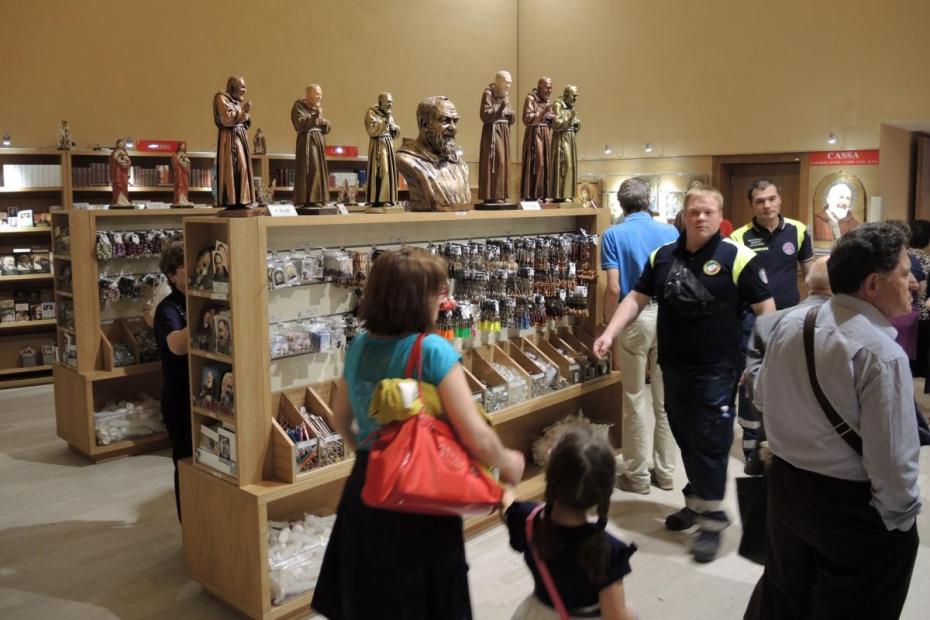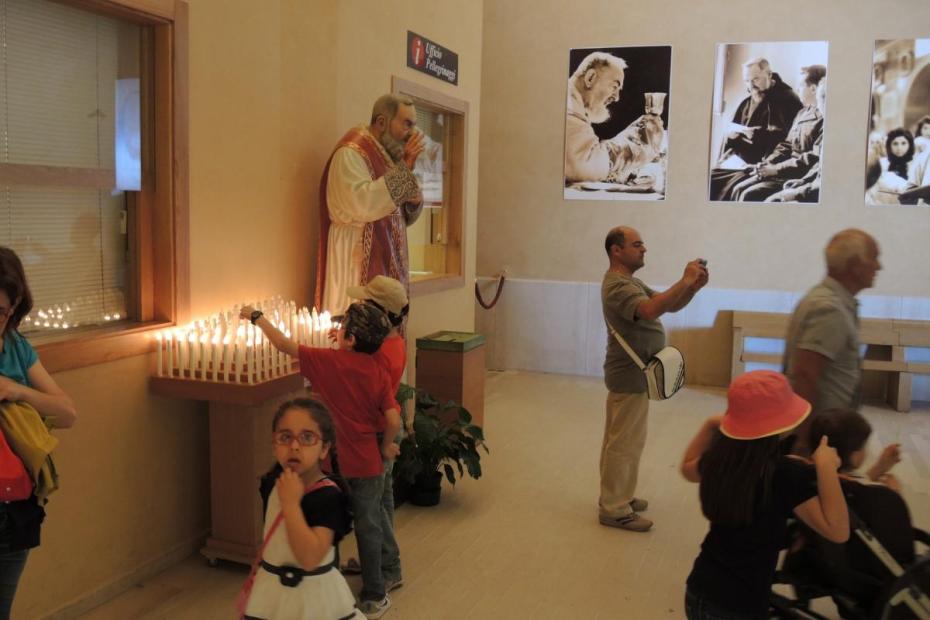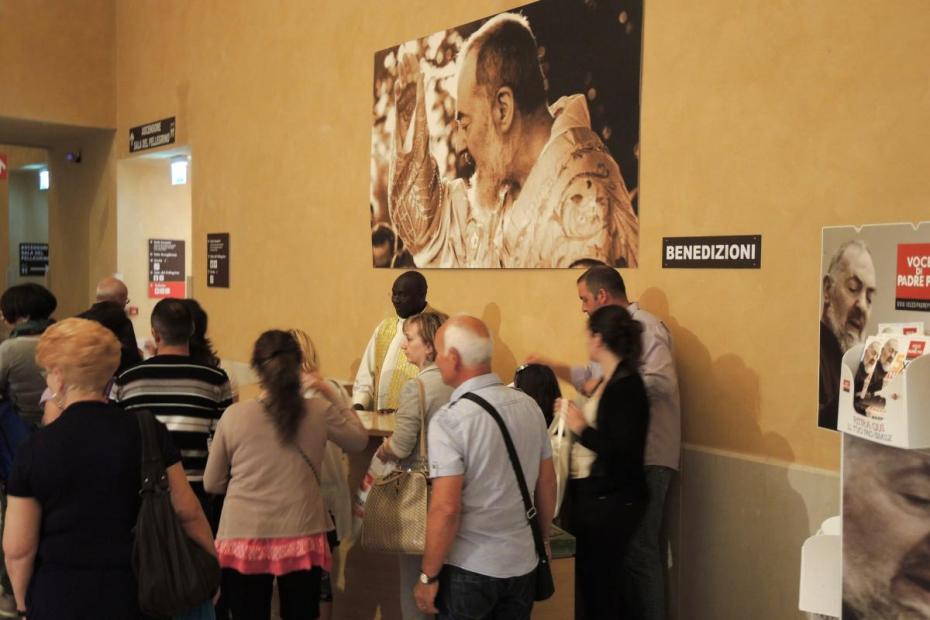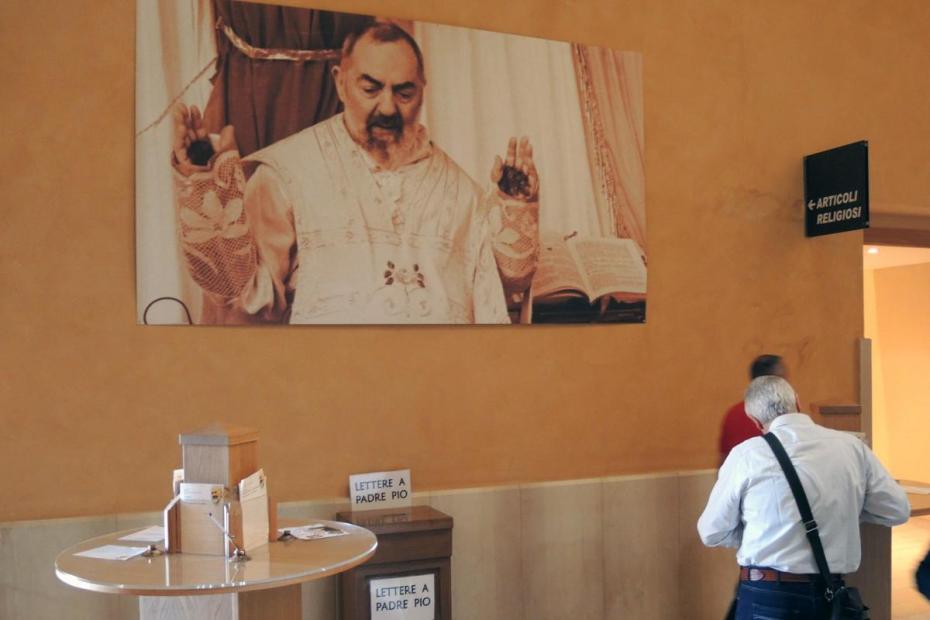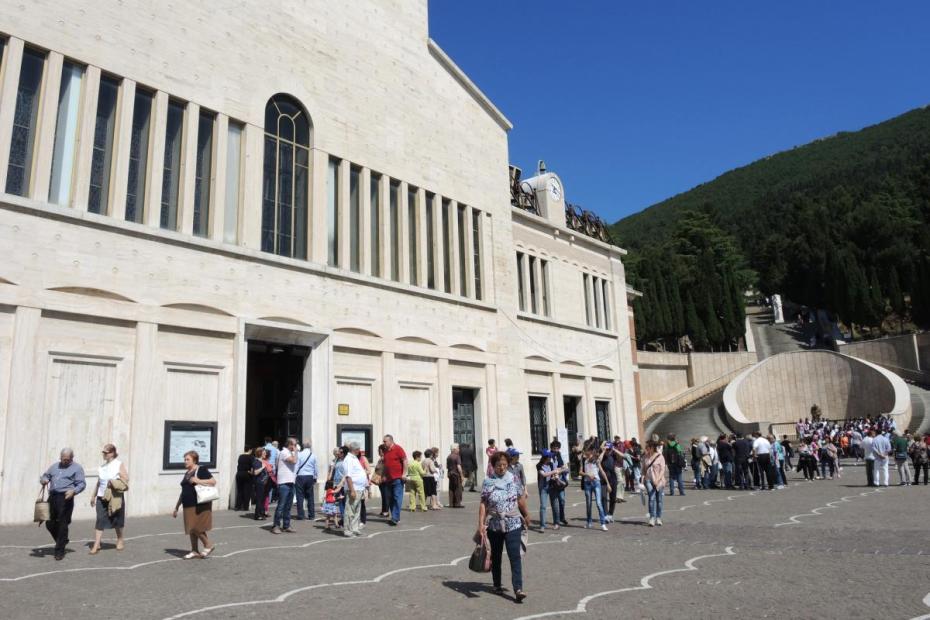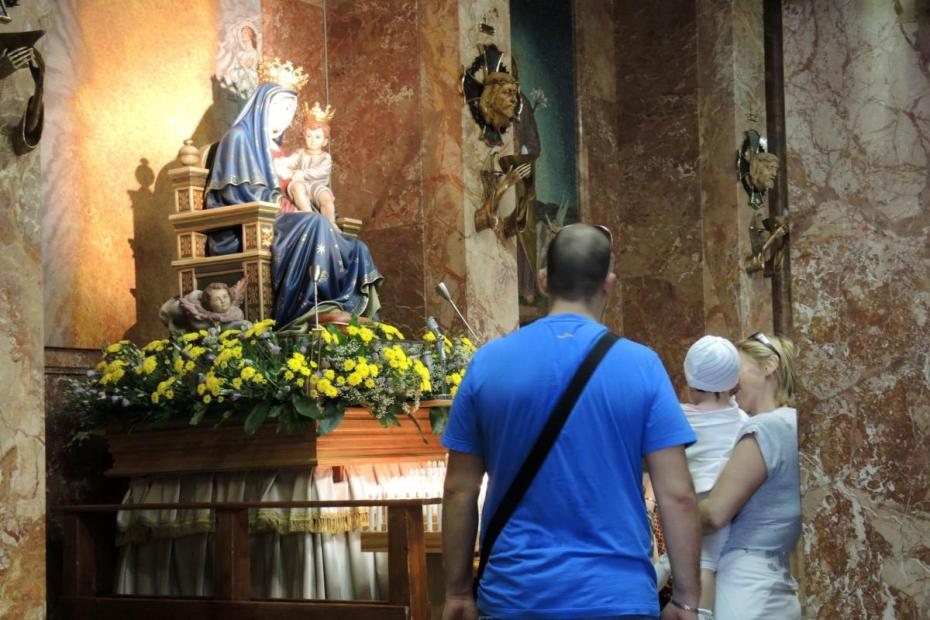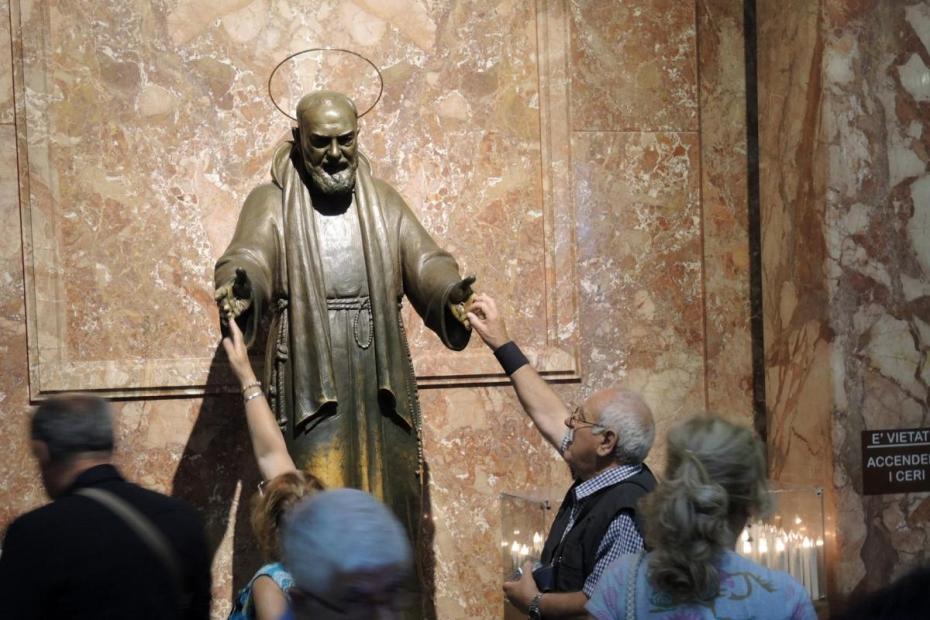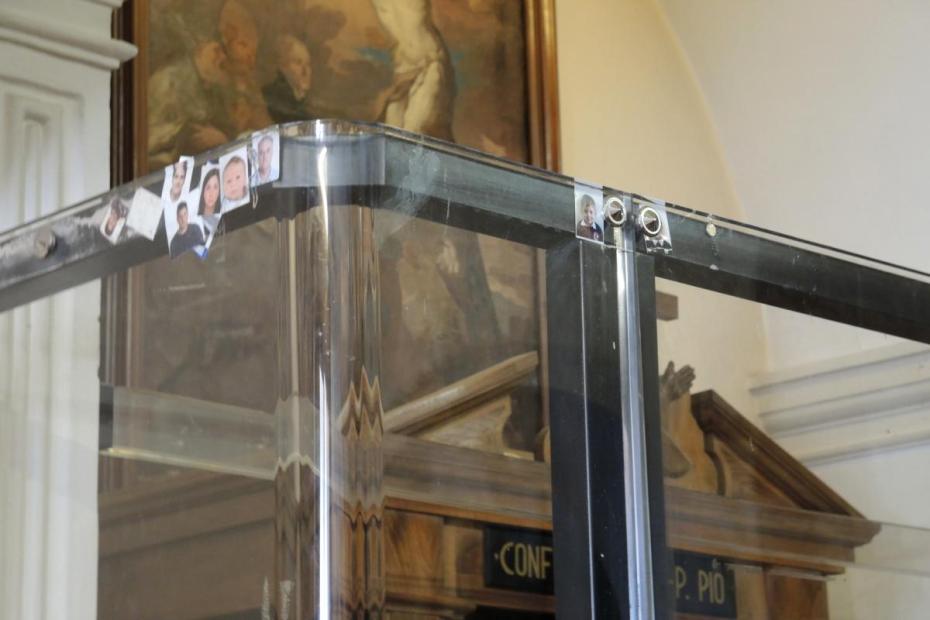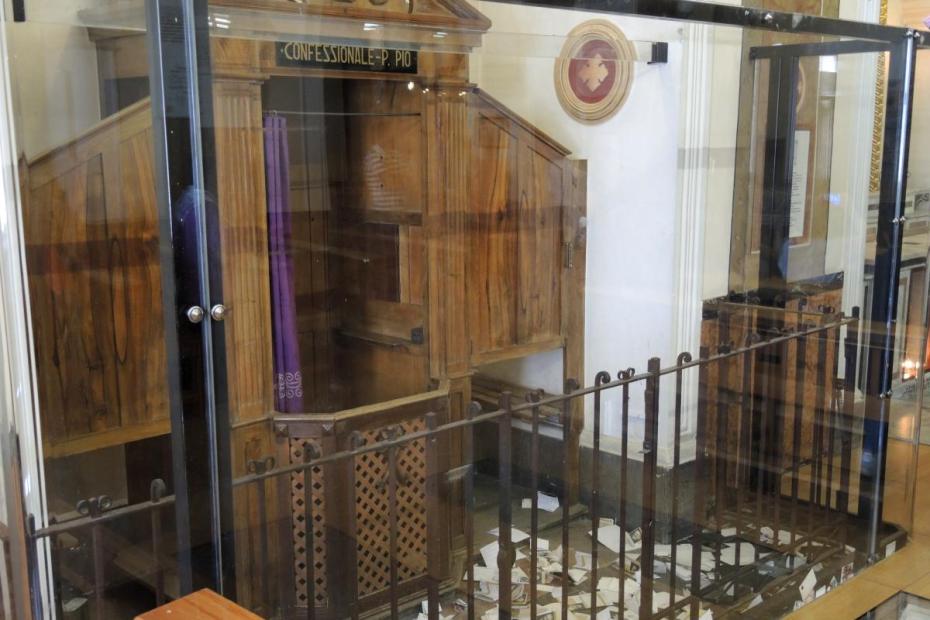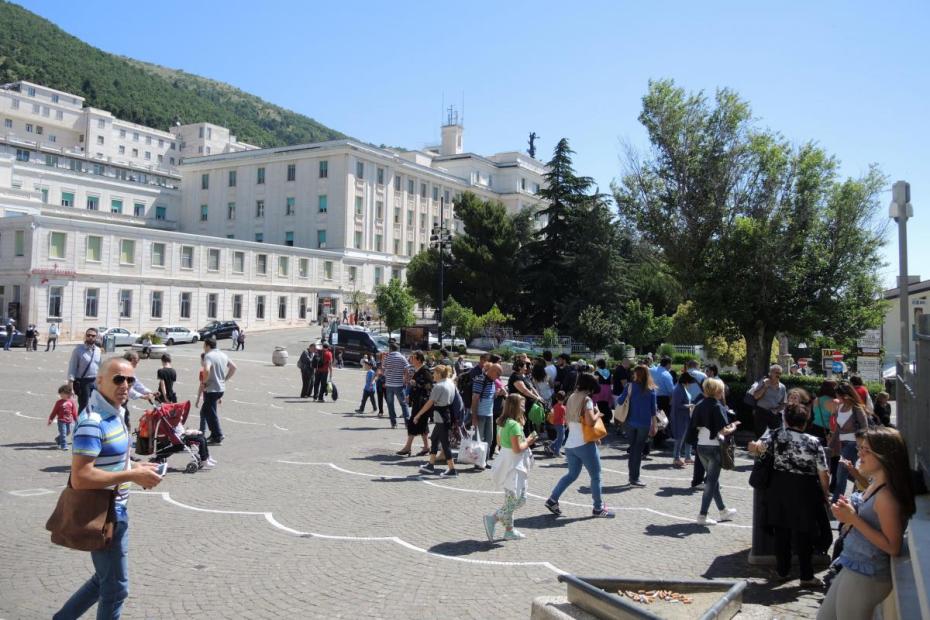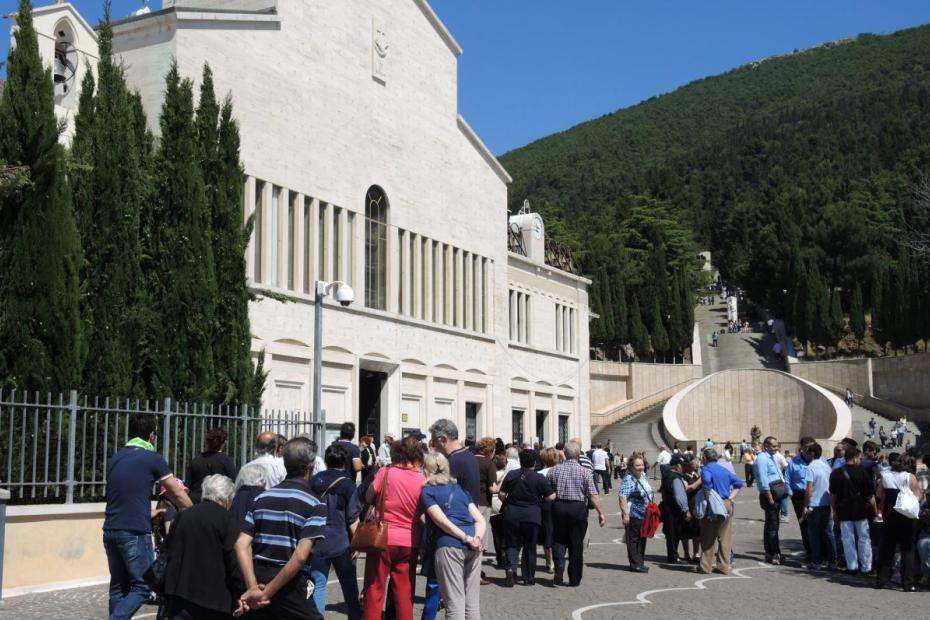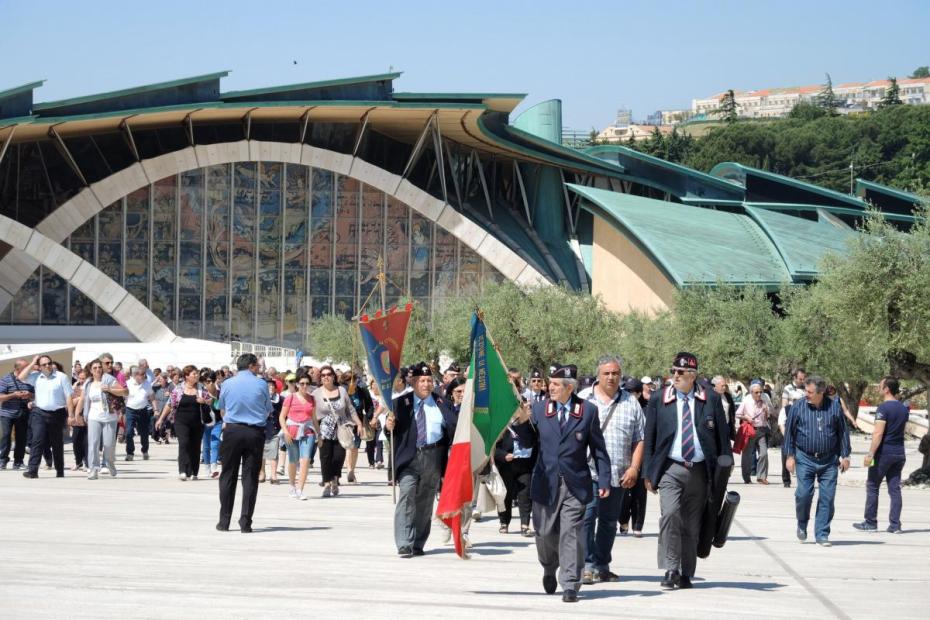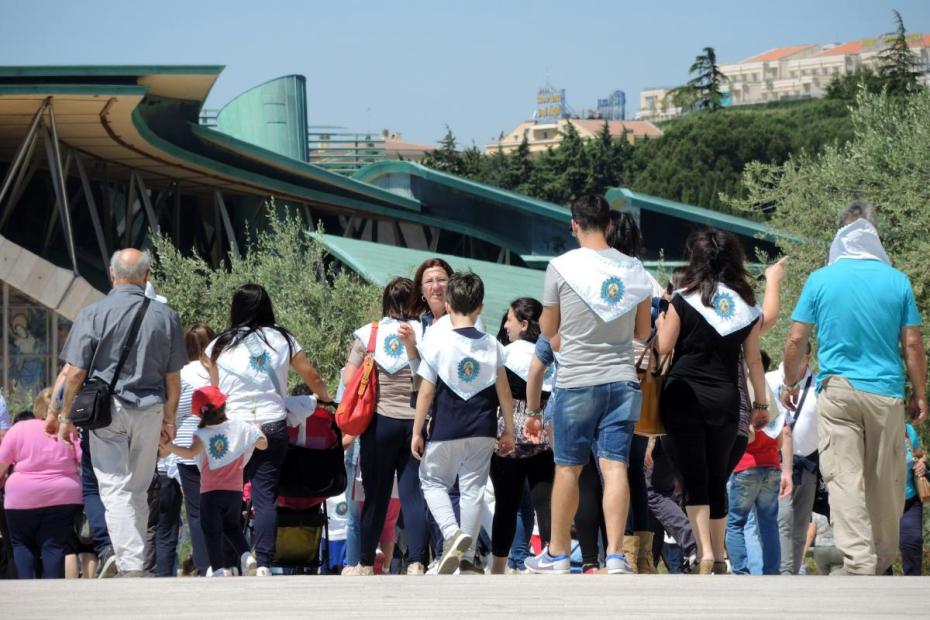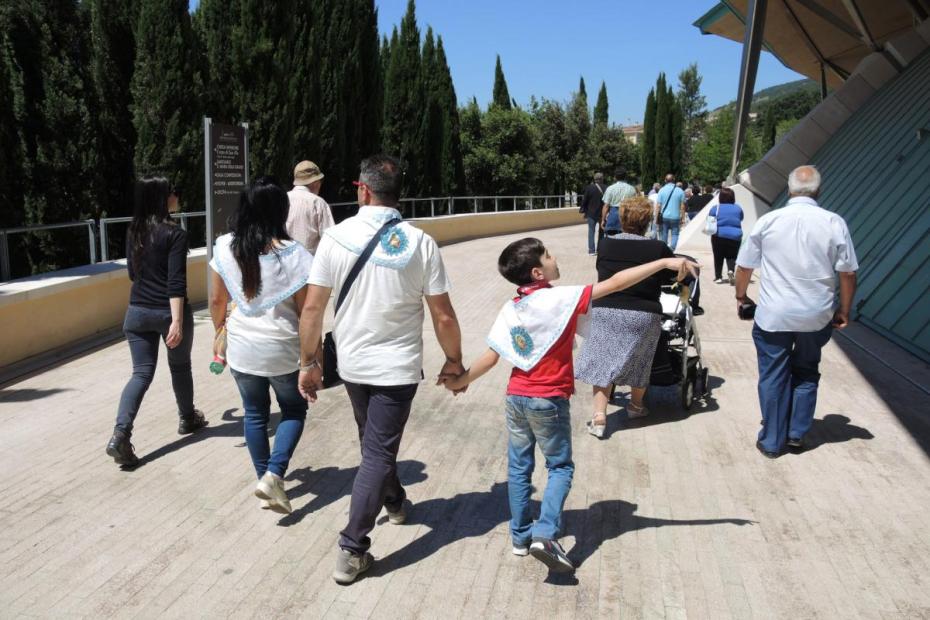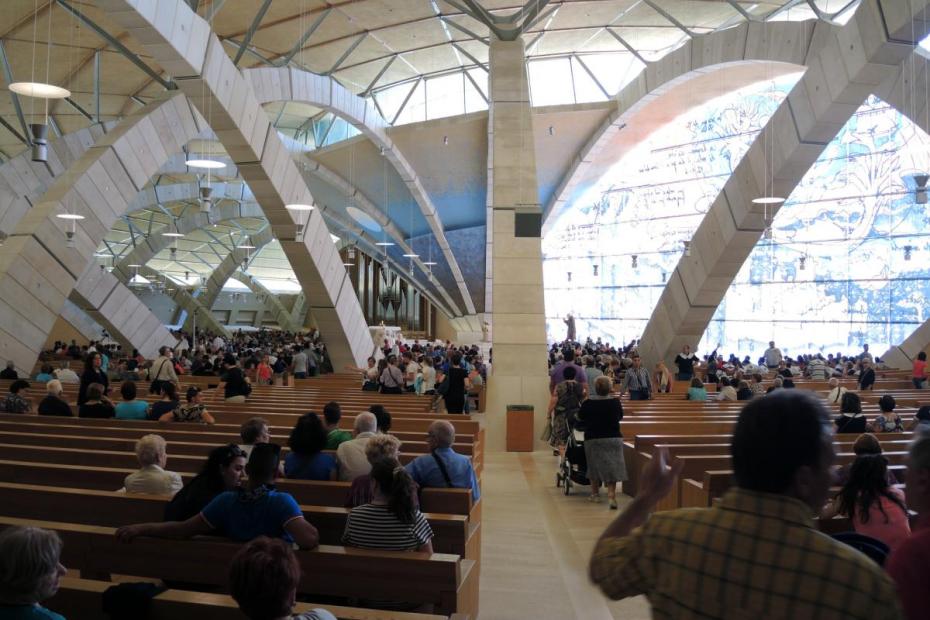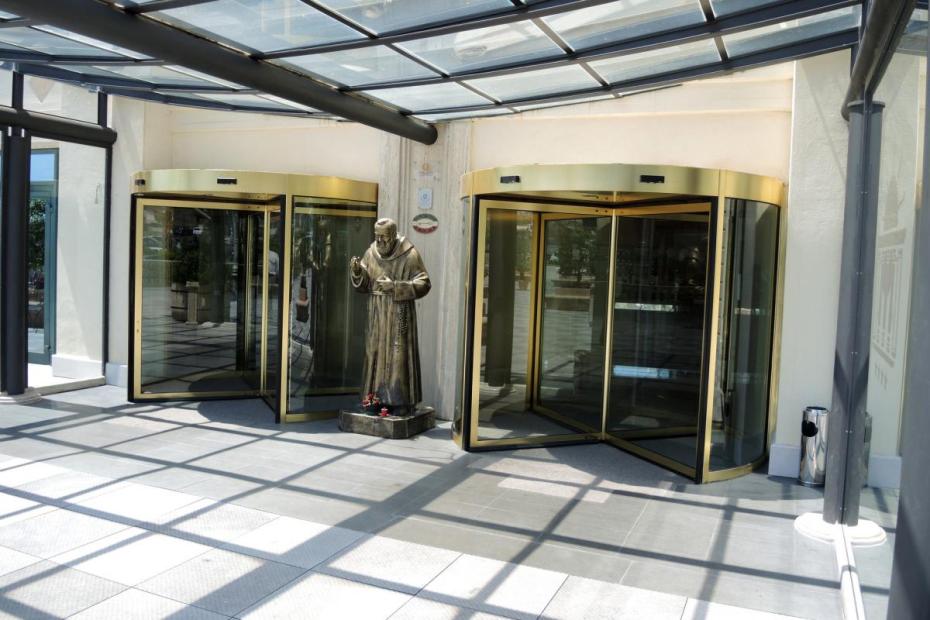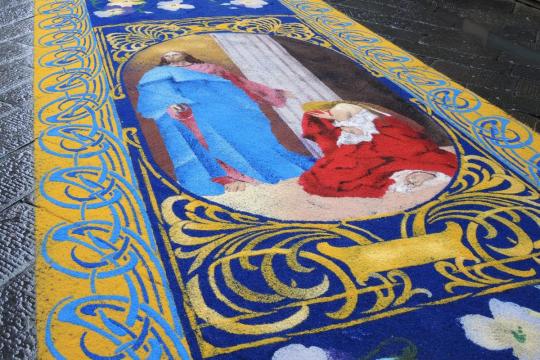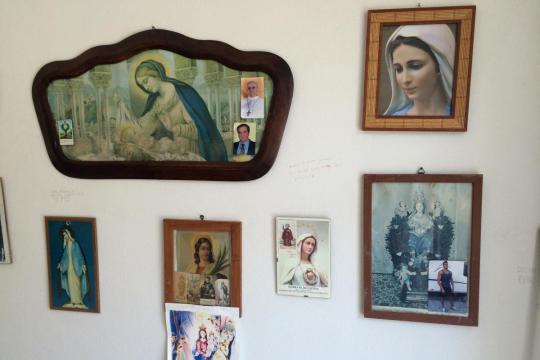In other parts of the world, two Italian saints could readily qualify as the people’s favorite. St. Francis, founder of the Franciscans, is probably the most popular saint in much of the Euro-American world. St. Anthony of Padua, a later follower of Francis, is especially popular in many parts of the world. In Italy, though, both figures seem to have been eclipsed by the cult of a 20th-century Capuchin Franciscan, Padre Pio (1887-1968). A controversial and charismatic figure in his lifetime, this peasant-born ascetic had manifestations of the stigmata for decades, and was widely sought as a confessor and intercessor. He has been cited as a modern-day suffering Christ figure, a miracle worker extraordinaire and a man with paranormal capacities like prescience and bilocation. In his lifetime, he oversaw the foundation of a major hospital, and his cult completely transformed the area around the convent where he lived, making it a major pilgrimage site.
Images of Padre Pio—sometimes multiple images—are to be found in many taxicabs and buses in Rome, and often as stickers on the back of cars.1 One student of the Padre Pio phenomenon claims that the vast majority of Italians he interviewed in 2000 owned some devotional image or object of Padre Pio, and goes so far as to call it “invasive” for its displacement of other Catholic cults in Italy. Side altars in churches all around Italy have added pictures of Padre Pio, all of which seem to have candles, flowers, and offerings left there. Italy has thousands of Padre Pio prayer groups, and ethnologist Peter Jan Margry reports that a four-hour television film broadcast on two nights drew 42% and 50% of all Italian viewers—12 and 14 million people—in 2000.2 Devotional literature about Padre Pio is ubiquitous, and the “Devoti di Padre Pio” even have a Facebook page with 1.1 million “likes” as of May 2021.
Pope John Paul II, who had a long-time devotion to Padre Pio, canonized him in 2002. Long before then, however, Pio aroused the suspicions of Pope Pius XI and Pope John XXIII, who each ordered investigations. After a report in which the Franciscan psychologist Agostino Gemelli, founder of a famous clinic and a Catholic University, judged Pio to be psychologically troubled, Pope Pius XI prohibited Pio from public ministry for two years. There were repeated attempts to move or investigate him in subsequent years.3
The shrine
There are shrines to Padre Pio in a number of places connected to his life, but the largest of these is at San Giovanni Rotondo, where he lived and worked for most of his life as a priest. San Giovanni Rotondo is in the Gargano, a mountainous region of Italy that on the map looks like the spur in the boot of Italy. The town was located along a pilgrimage route to San Michele in Monte Sant’Angelo. Founded by Padre Pio, the Casa Solleivo della Sofferenza (Home for the Relief of the Suffering) is a huge regional hospital built on the hill next to Padre Pio’s friary and the old church. It continues to expand and was the first hospital of its quality to serve the local population.
The shrine is 2 km from the old center of town; but as the hospital, the shrine and its tourist infrastructure have grown, the town and shrine have merged. In the alleys of the town today, far from the hotels and tourism, one also sees many images of Padre Pio on homes and street corners where natives live.
The San Giovanni Rotondo complex is quite remarkable, having grown from a small Capuchin convent and its tiny church of Santa Maria delle Grazie to encompass a major hospital in 1956 and a larger church in 1959. A huge new complex, featuring a church said to seat 7,000 people, a crypt, and a plaza for 30,000 people, was designed by celebrated architect Renzo Piano and dedicated in 2004. Down the hill from the church are large parking lots and many hotels for pilgrims. By some estimates, millions of pilgrims visit each year. More than 10,000 people were at the shrine during this research visit on a Sunday in June 2014.
Padre Pio’s body lies on display in the crypt of the church, visited by a steady stream of pilgrims. Devotional murals there tie him back into the story of St. Francis of Assisi, and to Jesus’ own crucifixion. All of this is the newest addition to the shrine. His body was exhumed in 2008, and was then put on display in a large glass case in the crypt. It was apparently decayed, but even that is debated.4
In any case, it has been covered with a silicone mask that makes him look like a recently dead figure. The insistence on displaying the body of Pio follows a cultural pattern in Italy—bodies and body parts of saints have long been displayed in Italy since they were brought into churches from the catacombs, but very few of these saints’ bodies have been described as incorruptible, and none to this author's knowledge is currently physically altered to look like bodies in a casket.5
Margry finds Padre Pio an oddity in a country “with such strong culturally determined views about ‘hygiene’ and la bella figura, where Pio is concerned a broad affinity has arisen for things for which people, generally speaking, feel a great aversion, such as personal confrontation with body fluids. There is great adoration for Pio’s wounds and blood, and all sorts of dirty, stained and unwashed items of clothing are displayed and revered, and rather repulsive photographs are constantly in view.”6
One view is that these are valued precisely because they powerfully invert the values of Italian culture, but this does not satisfactorily address how the values could take hold so powerfully in Italy, while only seeming strange in cultures that also place high emphasis on hygiene.
Devotees at San Giovanni Rotondo
Christopher McKevitt, who did extensive ethnographic research in San Giovanni Rotondo in 1986 and 1987, saw two types of devotion there: one characteristic of the many lay devotees who had moved to San Giovanni Rotondo to be close to Padre Pio and his cult (and were physically close to the shrine), and another characteristic of the native population.7 Both groups are devoted to St. Pio, but each for somewhat distinct reasons.
According to McKevitt, the devotees who moved to San Giovanni Rotondo often gave themselves over to fostering Padre Pio’s cult, whether at the shrine and its support operations or at guesthouses for pilgrims. He recounts that a number of these followers reported having visions, such as of Pio in a crown of thorns, of visions of the crucifixion while Pio was saying Mass. For these devotees, suffering, self-denial and penance were often at the center of their understanding of Padre Pio. Their relationship with grace entailed exchange: “Sacrifice paid for the redemption of individuals and for the graces—or miracles—[Padre Pio] was able to obtain for them from God… Graces—favors or miracles requested—have to be paid for, as I was often told by devotees of Padre Pio.” McKevitt argues that there was nothing passive about these devotees’ understanding of suffering, and that it put them in the midst of a very active cosmological realm, and helped infuse with meaning what were otherwise irremediable—and meaningless—losses. These believers, he said, long for miracles when they can find them, but grant powerful meaning to suffering when they must.8
For ordinary townspeople, McKevitt found, Padre Pio is perhaps most regarded for a different kind of relationship to suffering, as the man who founded their major regional hospital and as the magnet for pilgrims who fill local hotels and restaurants. He writes that for the many locals he interviewed, “Pio remains for them a man who entered their historical time and space and acted upon these to transform them. Some acknowledge his ability to work miracles, and regard him as a man marked out by the divine. Most, however, emphasize his humanity, not on the cosmological significance of his spirituality. All agree that Pio’s greatest miracle was an economic one, namely the construction of the Casa Sollievo della Sofferenza.”9
These locals reported to him their discomfort with the cult that arose around Padre Pio—the “fanaticism” of some of the visitors to the shrine, and the compromising of the sacredness of the place by the commercialism of the tourist infrastructure around it. For them, he reports, Padre Pio is valued because he connected with them and was there for their needs, as one of them, speaking their dialect. However, now the shrine’s value “has been undermined by the transformation and complication of its sacred nature.”10 While large crowds were in evidence during a visit to the shrine on a Sunday in June 2014, there was no apparent sign of fanaticism, but the commercialism is evident all along the main road below the shrine.
Another study of the pilgrims at San Giovanni Rotondo, conducted by Giuseppe Scarvaglieri in 1985, revealed the following as primary motives for devotion to Padre Pio: as “imitator of Christ,” an example of Christian life, 30%; because of the stigmata in particular, 24%; because of Pio’s compassion and charity, 19%; because of his miraculous powers, and as a healer, 19%; as a confessor, 4%; as a man of mystery, 4%.11
In the story of Padre Pio, believers can find a story of suffering and redemption, of patient trust in God. The pain of the stigmata and the suffering that mimics Jesus’ are pointed to as clear signs of his sanctity as a kind of suffering servant who takes on others’ suffering to relieve them of it.12 Yet the Home for the Relief of the Suffering suggests a countervailing attitude toward suffering, a modern attitude that it should be relieved physically and spiritually. Several Italians told me that the Casa is a primary reason why Pio has attracted such devotion, but of course it is hard to name another hospital founder who has a huge religious cult built around him or her, whose picture is on holy cards all over Italy’s cities, and who is enshrined in silicone in a crypt that people line up to visit and touch.
The figure and cult of Padre Pio stand in an odd relationship to the Italian Church, even after he has been canonized and the hierarchy’s prior doubts have been officially swept aside. The poor regard him as having been one of them, dedicated directly to them, having suffered like them, even at the hands of more powerful religious elites who did not understand him. He is said to stand in some way as a rebuke to the ways of other clergy and to the hierarchy who doubted him. Yet of course he was a priest and a friar, and everything about his mission fit within Catholicism’s own symbol system.13 His ascribed achievements fall squarely in the traditional categories of Catholic mysticism. As a priest who suffered as an “alter Christus,” his body bore the marks of who he is supposed to be: a man who recreates the sacrifice of Jesus daily at the altar.14 Finally, in a Church that modernized after Vatican II, Pio is a modern day example of an old-time Italian religion and an older model of sanctity that many elites would like to see left behind.
Read more
Christopher McKevitt, “San Giovanni Rotondo and the Shrine of Padre Pio,” in Contesting the Sacred: The Anthropology of Christian Pilgrimage, eds. John Eade and Michael Sallow (London: Routledge, 1991) 77-97. McKevitt contrasts perspectives of pilgrims, villagers, and transplanted resident devotees to the cult that has grown up at the shrine.
Christopher McKevitt, “To Suffer and Never Die: The Concept of Suffering in the Cult of Padre Pio de Pietrelcina” Journal of Mediterranean Studies, 1 (1991): 54-67.
Peter Jan Margry, “Merchandising and Sanctity: the invasive cult of Padre Pio” Journal of Modern Italian Studies 7, no. 1 (2002): 88-115. Margry stresses the degree to which the “devotional avalanche” of the cult of Pio has undermined other saints’ cults in Italy.
- 1Peter Jan Margry, "Merchandising and Sanctity: the Invasive Cult of Padre Pio," Journal of Modern Italian Studies 7, no. 1 (2002): 88-115.
- 2Margry, “Merchandising and Sanctity,” 102.
- 3For summaries of these controversies, see Margry, “Merchandising and Sanctity,” 90-91; and Alexander Stille, “The Strange Victory of Padre Pio” in The New York Review of Books, October 25, 2012. For a more extended review, see Sergio Luzzatto, Padre Pio: Miracles and Politics in a Secular Age, trans. Frederika Randall (Picador, 2011). The controversies have also sometimes been revisited in hagiographic Padre Pio devotional works, where they are regarded as being without merit and as a sign of the suffering and testing that actually validates Padre Pio’s sanctity.
- 4John Hooper, "Exhumed Body of Padre Pio Goes on Display," The Guardian, April 24, 2008.
- 5On the cult of incorruptibility, see Michael P. Carroll, Veiled Threats: the logic of popular Catholicism in Italy (Baltimore: Johns Hopkins, 1996), 25, 208-225.
- 6Margry, “Merchandising and Sanctity,” 93.
- 7Christopher McKevitt, "San Giovanni Rotondo and the shrine of Padre Pio," in Contesting the Sacred: The Anthropology of Christian Pilgrimage, ed. John Eade and Michael Sallnow, 77-97 (London: Routledge, 1991); Christopher McKevitt, "To Suffer and Never Die: The Concept of Suffering in the Cult of Padre Pio de Pietrelcina," Journal of Mediterranean Studies (1991): 54-67.
- 8McKevitt, "To Suffer and Never Die," 54-67.
- 9McKevitt, "San Giovanni Rotondo," 77-97.
- 10McKevitt, “San Giovanni Rotondo,” 87-89.
- 11The survey is a summary of categories based on an open-ended question in the survey. Giovanni Scarvaglieri, Pelegrinaggio ed Esperienza Religiosa (Padre Pio da Pietrelcina, 1987), 228-246, as reported in Margry, “Merchandising and Sanctity,” 94.
- 12Some of McKevitt’s more devoted interviewees claimed visions that connected Padre Pio’s sufferings directly to Jesus’s suffering. McKevitt, “San Giovanni Rotondo,” 90-91.
- 13McKevitt, "San Giovanni Rotondo," 83-84, 90.
- 14McKevitt, "To Suffer and Never Die," 57, 59.
